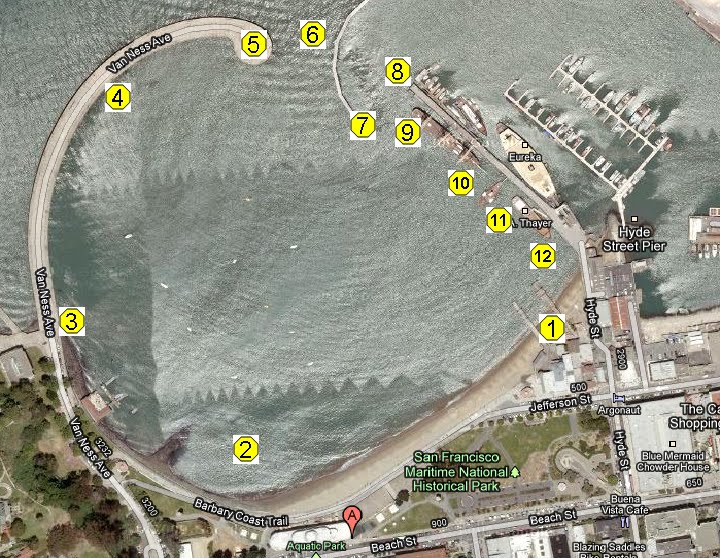Monday 12/21/09
As it has every year since 1974, the Polar Bear swim started today. Many cities boast “polar bear” swims. In Chicago and Boston, bathers wade into Lake Michigan and the Atlantic on New Year’s Day and stay for several seconds. In the arctic countries, people regularly cut holes in the ice and frolic as many as two minutes. The Dolphin Club Polar Bear lasts all winter. It runs from the Winter Solstice on December 21 until it ends on March 21 with the arrival of the Spring Equinox. Members keep track of their distance in quarter-mile increments on large, quadrilled charts mounted at the entrance to the club. Logically, swimmers often refer to the distance they’ve covered in a day in terms of squares. “We did four squares today—at least a mile.” Since 1984, earning a polar bear requires swimming forty miles (or 160 squares) in the San Francisco Bay or equivalent cold, open water. An official notice on the sign-up sheet some few years ago proclaimed that “the use of wetsuits and/or swim aids is viewed with scorn and contempt.”
This swim was the inspiration of Bill Powning. The original Polar Bear began in 1974 when the requirement was set at twelve miles. In those days, Bay swimming was pretty much confined to the relatively warmer summers. For both clubs at the time, handball was the predominant winter sport. It vied only with holiday bacchanalia for popularity. Mr. Powning wanted to swim in the winter, though, and he wanted company. Cleverly, he titled the event “The Polar Bear Challenge” knowing what would spur maximum participation from the all-male membership at the time. It worked. Over the years, the mileage bar rose to eighteen, then twenty, then thirty, until it reached its current mark at forty miles. In the early 1990’s some members, perhaps facetiously, agitated for a fifty mile Polar Bear. They met with stalwart resistance and the topic was soon dropped.
Since its inception, earning a “polar bear” has meant being recognized with the gift of a three-quarter inch block of white marble. For virgin recipients, these awards are mounted with a small replica of a polar bear. Perversely, this trinket is not distributed until the November awards dinner. The memento provides a timely reminder to participants of their previous winter accomplishment and tacitly encourages them to go for one more.
For many, these marble blocks stray into drawers and closets and other hidden corners; perhaps serving as a paperweight here or a doorstop there. Not so for Mr. Powning. He glued his blocks together, creating a towering trophy reflecting the glory of his consecutive string of successful polar bears. By the time he stopped swimming, Mr. Powning held the undisputed record. The current consecutive polar bear record belongs to Vincent Huang whose first polar bear dates to the 1978-1979 season. Emulating the Polar Bear Challenge founder, Mr. Huang's stack of thirty-one glued marble blocks is only a few short years from reaching a full yard long. Mimi Osborne holds the women’s record. She started swimming the polar bear in 1980, shortly after women were admitted to the Dolphin Club. Her consecutive string stands at twenty-nine.
It wasn’t until the 1984-1985 season that the custom emerged of crowning a polar bear champion. The occasion for this was the first polar bear of more than one hundred miles. Elmer Tosta swam 101.5 miles that winter. His name was the first to grace the perpetual trophy plaque that hangs in the Staib Room of the Dolphin Club today. Since then, nine people have swum 200 miles or more during the Polar Bear Challenge. Among these is Joe Illick, a four-time winner who snagged his first championship at the age of 69. George Kebbe set a record many believed unsurpassable when he swam 255 miles one winter. A few winters later, though, Suzie Dods swam 256 miles. The next year, Mr. Kebbe returned to swim 356 miles, a mark that would surely stand forever. And it did until Ralph Wenzel tied the record with his own 356 mile polar bear in 2007.
A new wrinkle in the Polar Bear Challenge is recognition for the “first to forty.” The year of its inception, the competition was over before the New Year began. Then Peter Perez extended the idea of “double-dipping.” Most modern Polar Bear Challenge winners swim twice a day. It’s simply too cold to swim four miles in one effort. However, a “triple dip” would inevitably evoke remark. Mr. Perez had a theory, though. He hypothesized that a person could repeatedly swim a distance to the point of becoming only slightly uncomfortable; warm up; and immediately return to the water. He considered sleep deprivation the only barrier to doing this indefinitely. Putting his theory to the initial test in 2006, he successfully swam all forty miles in slightly more than four days. Copying his method, faster swimmers have shaved that record to about three and a half days.
Mr. Perez’ goal this year is to swim forty miles in less than two days. He started his first dip at 12:01a this morning. By 9:00a, he was working on his eighth mile. He is scheduled to attempt the English Channel in August, 2010 and believes that this effort is good physical and mental preparation. Although the swimming itself is interrupted, it has many of the same elements of discipline, pain, and constant exertion over a long period.
I’m sorry that Bill Powning can’t bear witness to these extraordinary endeavors. He was a wonderful sauna companion and would surely have some entertaining remarks regarding the evolution of his original notion.
6 years ago


I didnt know Elmer had the first over 100!!
ReplyDeleteSuzie D
Neither did I!
ReplyDeleteAnyway, Now I have realized it, it has turns out into something really concerning, hasn't it?